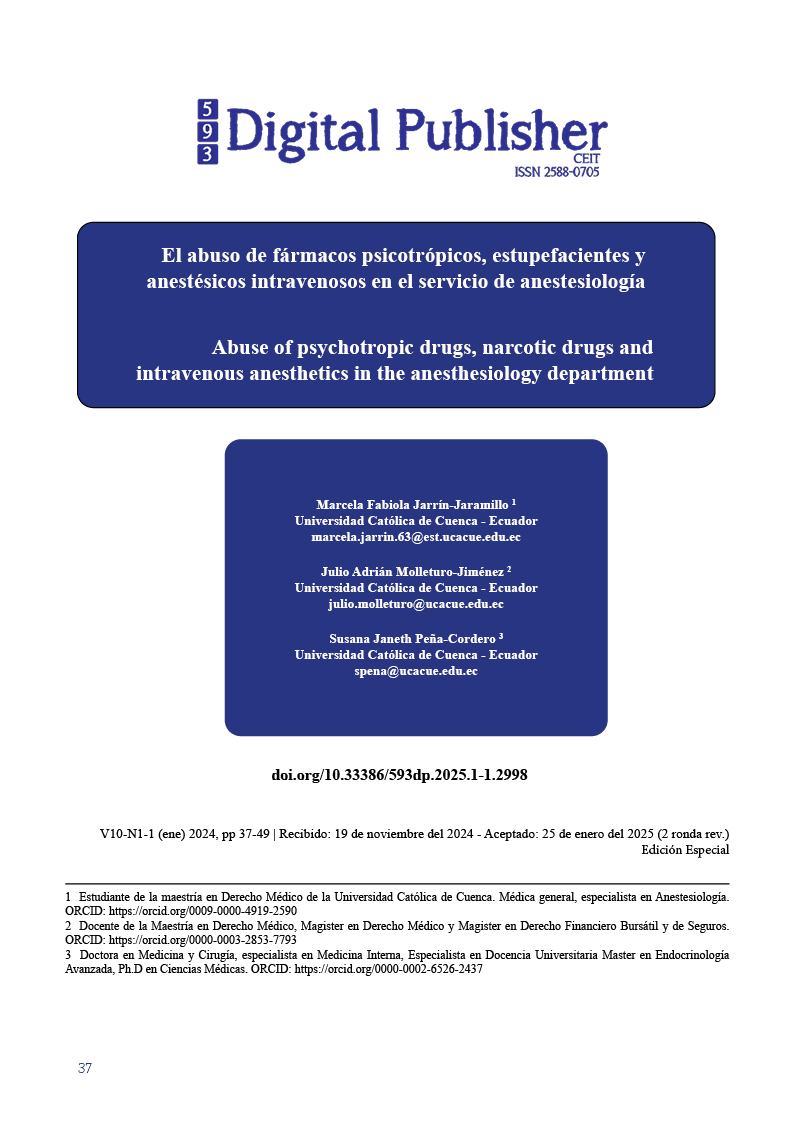Abuse of psychotropic drugs, narcotic drugs and intravenous anesthetics in the anesthesiology department.
Main Article Content
Abstract
Anesthesiology service personnel are susceptible to the abuse of narcotics, psychotropic drugs and intravenous anesthetics, in part due to the easy access to these drugs. As health personnel it is their duty to procure the patient's wellbeing, in cases of abuse, the professional puts the patient and him/herself at risk. OBJECTIVE: To analyze the medical-legal aspects of the abuse of psychotropic and intravenous anesthetics by anesthesiology service personnel. METHODOLOGY: A systematic review of the medical literature in specialized databases was carried out, selecting 28 articles of greater relevance. RESULTS: Two cases related to the criminal liability of anesthesiology service personnel were found, one case showing the consequences on mental health. CONCLUSION: Substance abuse in anesthesiology personnel can have serious legal consequences. We recommend the revision of the classification of propofol, since it is a drug of potential abuse.
Downloads
Article Details

This work is licensed under a Creative Commons Attribution-NonCommercial-ShareAlike 4.0 International License.
1. Derechos de autor
Las obras que se publican en 593 Digital Publisher CEIT están sujetas a los siguientes términos:
1.1. 593 Digital Publisher CEIT, conserva los derechos patrimoniales (copyright) de las obras publicadas, favorece y permite la reutilización de las mismas bajo la licencia Licencia Creative Commons 4.0 de Reconocimiento-NoComercial-CompartirIgual 4.0, por lo cual se pueden copiar, usar, difundir, transmitir y exponer públicamente, siempre que:
1.1.a. Se cite la autoría y fuente original de su publicación (revista, editorial, URL).
1.1.b. No se usen para fines comerciales u onerosos.
1.1.c. Se mencione la existencia y especificaciones de esta licencia de uso.
References
Acuña, J. P., & Alvarez, J. P. (2017). Sanando al sanador. Revista Medica Clinica las Condes, 756- 769.
Amaya, S., & Nomesque, J. (2023). Acciones claves para la prevención y rehabilitación del trastorno por uso de sustancias en anestesia. Revista chilena de anestesia, 100- 107.
ARCSA. (Agosto de 2021). https://www.controlsanitario.gob.ec/. https://www.controlsanitario.gob.ec/: https://www.controlsanitario.gob.ec/wp-content/uploads/downloads/2021/08/2021_preguntas-frecuentes-Med-sujetos-fiscalizacion.pdf
Asamblea nacional del Ecuador. (3 de Febrero de 2014). Codigo Organico Integral Penal. Codigo Organico Integral Penal: www.defensa.gob.ec
Bocanegra, J. C., & Gomez, L. M. (2023). Adverse events in anesthesia: Analysis of claims against anesthesiologists affiliated to an insurance fund in Colombia. Cross-sectional study. Colombian Journal of Anesthesiology, 1-9.
Boussofara, M. (2016). Farmacología de las benzodiazepinas utilizadas en anestesia-reanimación. EMC - Anestesia-Reanimación, 1-11.
Bryson, E. (2018). The opioid epidemic and the current prevalence of substance use disorder in anesthesiologists. Current Opinion in Anaesthesiology , 388-392.
Burnett, G., & Taree, A. (2022). Propofol misuse in medical professions: a scoping review. Canadian Journal of Anesthesia, 395-405.
Cho, H.-Y. (2022). Propofol abuse among healthcare workers: an analysis of criminal cases using the database of the Supreme Court of South Korea’s judgments. Korean Journal Anesthesiology, 391-396.
da Silva, J. V. (2021). Risk of mortality and suicide associated with substance use disorder among healthcare professionals: A systematic review and meta-analysis of observational studies. European Journal of Anaesthesiology, 715-734.
DeFord, S., & Bonom, J. (2019). A review of literature on substance abuse among anaesthesia providers. Journal of research in Nursing, 1-14.
Dinis-Oliveira, R., & Magalhães, T. (2020). Abuse of Licit and Illicit Psychoactive Substances in the Workplace: Medical, Toxicological, and Forensic Aspects. Journal of Clinical Medicine, 1-18.
Fitzsimons, M., & Baker, K. (2018). Reducing the Incidence of Substance Use Disorders in Anesthesiology Residents. Anesthesiology, 821-828.
Fitzsimons, M., & Baker, K. (2018). Reducing the Incidence of Substance Use Disorders in Anesthesiology Residents: 13 Years of Comprehensive Urine Drug Screening. Anesthesiology, 821-828.
Fitzsimons, M., & Soares de Sousa, G. (2023). Prevention of drug diversion and substance use disorders among anesthesiologists: a narrative review. Brazilian Journal of Anesthesiology, 810-818.
Gwiazdaa, S., & Dixon, E. (2021). Propofol misuse in Ireland – Two case reports and a review of the literature. Forensic Science International, 326-331.
Haberer, J. (2021). Propofol: farmacodinámica y uso práctico. EMC - Anestesia-Reanimación, 1-91.
Harvey, S., & Epstein, R. (2021). Mental illness and suicide among physicians. The Lancet, 920-930.
https://www.controlsanitario.gob.ec/. (Agosto de 2021). https://www.controlsanitario.gob.ec/: https://www.controlsanitario.gob.ec/wp-content/uploads/downloads/2021/08/2021_preguntas-frecuentes-Med-sujetos-fiscalizacion.pdf
Huertas, E., & Suarez, O. (2017). La adicción en el anestesiólogo: ¿Cómo prevenirla y detectarla? Bogota: Editorial S.C.A.R.E.
Kadlec v. Dr. David Baldone; Dr. Allan Parr, Defendants-Cross-Appellees, 06-30745 (United States Court of Appeals,Fifth Circuit 8 de Mayo de 2008).
Kiryakova, T. (2018). Self-administrated propofol - a case report of a physician suicide. Toxicologie Analytique & Clinique, 1-7.
Lefebvre, L., & Kaufmann, M. (2016). The identification and management of substance use disorders. Canadian Journal of Anesthesia, 211-218.
Mendez, M., & Romero, B. (2016). Neurobiologia de las adicciones. Revista de la Facultad de Medicina de la UNAM, 6-16.
Miller, R. (2016). Miller Anestesia. Barcelona: Elsevier.
Robotti, S. (24 de Agosto de 2019). https://medshadow.org/. https://medshadow.org/: https://medshadow.org/drug-classifications-schedule-ii-iii-iv-v/
Serebrenic, F., & Carvalho, M. (2021). Postmortem qualitative analysis of psychological, occupational, and environmental factors associated with lethal anesthetic and/or opioid abuse among anesthesiologists: case series. Brazilian Journal of Anesthesiology, 317- 325.
Wallace, C. (2023). UCSD, anesthesiologist cleared of allegations the health system ignored physician fentanyl abuse. Beckers asc review, 1-2.
Young-Tae, J. (2015). Propofol as a controlled substance: poison or remedy. Korean Journal of Anesthesiology, 525-526.
Zuleta-Alarcon, A., & Coffman, J. (2017). Non-opioid anesthetic drug abuse among anesthesia care providers: a narrative review. Canadian Journal of Anesthesia, 169-184.




